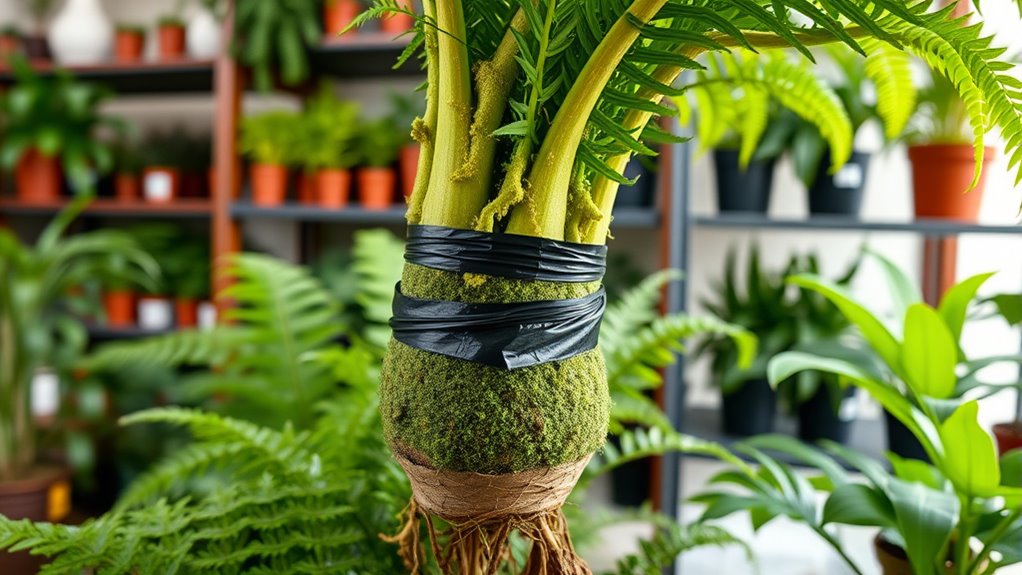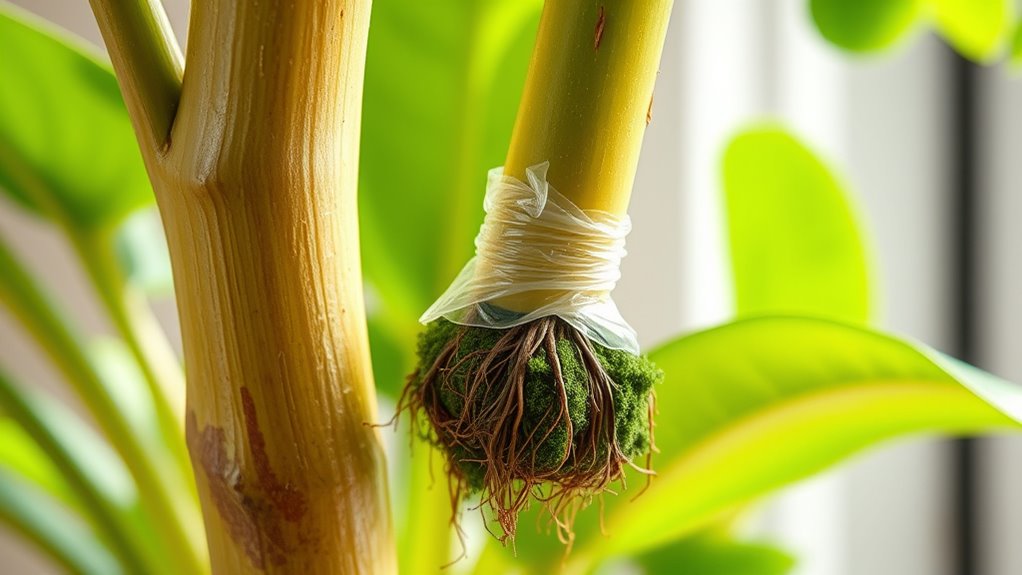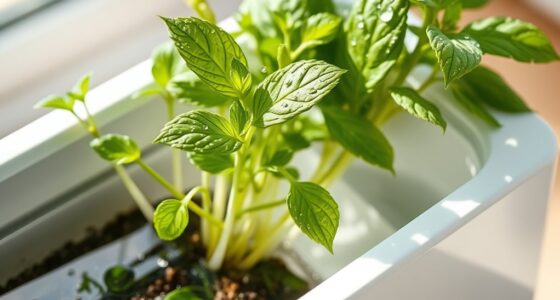To propagate indoor plants more effectively, you can try air layering, which involves wounding a stem, wrapping it with moist sphagnum moss, and covering with plastic until roots form. Other advanced methods include grafting or tissue culture, helping you grow plants that are difficult to root through simple cuttings or seeds. Mastering these techniques can save time and improve success rates. Keep exploring to discover detailed steps that make these methods easy to try yourself.
Key Takeaways
- Air layering creates roots on a stem by wrapping it with moist sphagnum moss and plastic, ideal for woody indoor plants.
- Proper wound preparation and maintaining consistent moisture are crucial for successful air layering.
- Other advanced techniques include grafting and tissue culture, suitable for rare or difficult-to-root indoor plants.
- Combining air layering with seed or cutting propagation can increase plant diversity and propagation success.
- Monitoring environmental conditions and practicing patience are essential for mastering these advanced propagation methods.

Indoor plant propagation is a rewarding way to expand your greenery without spending extra money. While the most common methods like cutting propagation and seed starting are straightforward, advanced techniques like air layering take your plant propagation skills to the next level. These methods are especially useful for plants that are difficult to propagate through simple cuttings or seed starting alone. With a little practice and patience, you can multiply your favorite indoor plants efficiently and effectively.
Cutting propagation is one of the simplest and most popular methods, involving taking a healthy stem or leaf, then placing it in water, soil, or a propagation medium to develop roots. It’s perfect for many houseplants like pothos, philodendrons, and snake plants. When you cut, make sure to use clean, sharp scissors or pruning shears to prevent disease. After cutting, remove any lower leaves that might rot when in contact with soil or water. You’ll want to keep the cutting in a warm, bright spot, but out of direct sunlight to encourage root growth. While waiting, maintain consistent moisture levels to prevent the cutting from drying out. Once roots are a few inches long, you can transplant the new plant into soil or a pot, giving it the best chance to thrive.
Cut healthy stems or leaves and root them in water or soil for easy indoor plant propagation.
Seed starting is another fundamental propagation method, especially for plants that do not root easily from cuttings. It involves sowing seeds in a suitable growing medium and providing the right conditions for germination. For indoor plants, seed starting can be a fun project that yields new plants from scratch. Keep the soil consistently moist and maintain a warm temperature to promote germination. Once seedlings emerge, give them plenty of light and gradually introduce them to more direct sunlight. Seed starting is particularly useful for annuals or tropical plants that you want to grow from the very beginning, but it requires patience as germination can take days or weeks, depending on the species. Understanding the importance of light conditions can significantly improve germination success.
Beyond these basic methods, advanced techniques like air layering allow you to propagate plants while keeping the mother plant intact. Air layering involves creating a wound on a stem, then wrapping it with moist sphagnum moss and plastic to encourage roots to form right on the parent plant. Once roots develop, you cut the new plant from the parent and pot it separately. This technique is especially effective for woody plants or those with thick stems, such as ficus or rubber plants. While more involved than simple cuttings or seed starting, air layering offers a higher success rate for certain species and can produce a mature, ready-to-go new plant in less time.
Mastering these advanced propagation techniques enables you to grow a diverse collection of indoor plants, saving money and gaining satisfaction from nurturing new life.
Frequently Asked Questions
Can Air Layering Be Used on All Indoor Plant Species?
You wonder if air layering works on all indoor plant species. While it’s a versatile technique, species adaptability varies, and some plants respond better than others. You should know that technique limitations exist; not every species forms roots easily through air layering. For successful propagation, research your specific plant’s needs. If it’s compatible, you’ll likely see good results, but for some, alternative methods might be more effective.
What Are the Best Times of Year for Advanced Propagation?
You want to know the best times of year for advanced propagation. The key is seasonal timing; you should aim for the most favorable periods when plants are naturally growing actively. Typically, spring and early summer are ideal because plants have abundant energy and nutrients. Avoid winter, as growth slows down. By timing your efforts during these periods, you’ll improve your chances of successful propagation and healthy new plants.
How Do I Prevent Infections During Complex Propagation Methods?
Imagine you’re the health inspector of your plant’s world. To prevent infections during complex propagation, follow sterilization procedures like disinfecting tools and using sterile materials. Keep your workspace clean and avoid handling multiple plants simultaneously. Practice disease management by inspecting cuttings for signs of pests or disease. These steps help prevent contamination, ensuring your propagation success stays healthy and vibrant, just like a well-maintained vintage gadget.
Is Special Equipment Necessary for Advanced Propagation Techniques?
You don’t need special equipment for advanced propagation techniques, but having the right propagation tools makes the process easier. Basic tools like sharp pruning shears and rooting hormone are essential, while more complex methods may require specific items like wax or grafting tapes. Equipment requirements vary depending on the technique, but you typically won’t need anything too elaborate—just guarantee your tools are clean to prevent infections.
How Long Does It Typically Take for Propagated Plants to Mature Indoors?
When wondering how long it takes for propagated plants to mature indoors, keep in mind that growth timeline varies by plant type. Generally, you’ll see initial growth within a few weeks, but reaching maturity milestones can take several months to a year. Factors like light, temperature, and care influence this process. Stay patient, provide consistent care, and you’ll eventually enjoy fully grown plants, marking their journey toward maturity.
Conclusion
By mastering air layering and other advanced propagation techniques, you’ll transform your indoor garden into a lush, sprawling jungle that rivals the Amazon rainforest. Imagine your plants bursting with energy, filling every corner with vibrant greenery so dense it feels like stepping into a secret paradise. With these methods, you’ll become a true botanical wizard, turning tiny cuttings into majestic indoor forests faster than you ever thought possible. Get ready to create a living masterpiece that leaves everyone breathless!










